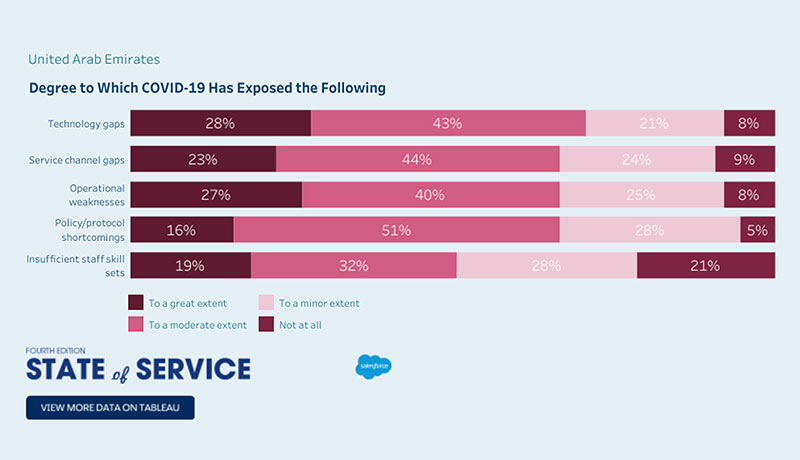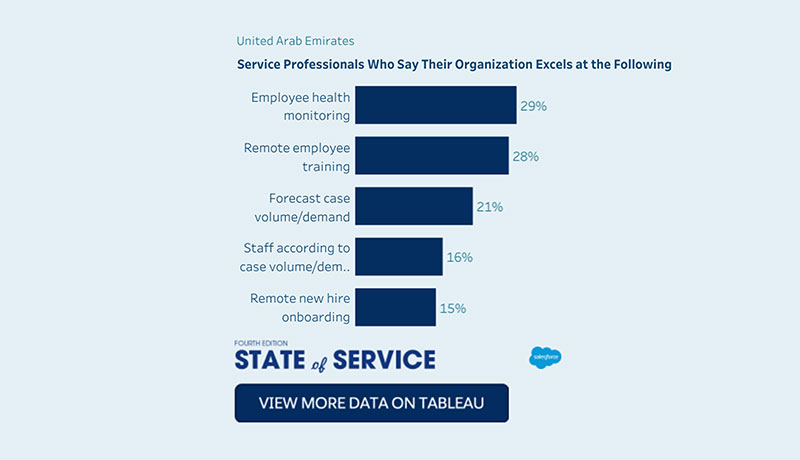
As the serial crises of 2020 redefine customer engagement, while 92% of service professionals in the UAE say the pandemic exposed technology gaps, customer service leaders are transforming their operations, accelerating digital transformation, and overhauling their workforce management strategies.
That’s according to Salesforce’s fourth State of Service research report, released, which provides a snapshot of the priorities, challenges, and trajectories of customer service teams in the UAE and around the world. This edition is based on Salesforce’s largest and most global survey of customer service agents, decision-makers, mobile workers, and dispatchers: over 7,000 respondents across 33 countries.
“While 92 percent of the UAE’s organizations faced technology gaps during the pandemic, they are taking this time to rethink the value of experiences and reimagine engagement with customers and employees alike,” said Thierry Nicault, Regional Vice-President, Middle East and Africa, Salesforce. “We will see more agile, innovative, and relevant organizations emerge, and the leaders will remove friction from every user experiences. Organizations also need to enhance training and onboarding of remote employees to deliver more customer-centric experiences.”
Based on Salesforce’s previous research, businesses no longer view their service and support operations as cost centers, but as strategic assets that benefit revenue and retention as customer expectations soar. This research helps Salesforce and its customers to understand how the playbook is changing, and what the best teams do differently from their competitors as they move back into growth mode.
From the channels they use to serve customers, to the spaces employees work from, to the skill sets agents require, there’s not much that hasn’t changed for customer service organizations. Here are some key takeaways.

The impacts of COVID-19 were a wake-up call for customer service organizations used to the status quo. As workers stayed at home and customers asked questions for which there were no answers, customer service leaders were faced with conundrums with far-reaching consequences for their teams.
In the UAE, 92% percent of service professionals say the pandemic exposed technology gaps, and 91% say the same for service channel gaps as customers flocked away from physical locations and towards digital methods of engagement.
Teams also found shortcomings that went beyond the obvious. For example, 95% realized that their existing policies and protocols — such as cancellation fees for events that were prohibited by public health measures — were not suited for current circumstances.

A related research report, “State of the Connected Customer,” shows the extent to which customers have shifted to digital, as well as how that shift is expected to persist. Consumers and business buyers in the UAE estimate that 67% of their interactions with companies will occur online in 2021.
This uptick has coincided with a surge in adoption of various digital channels by service organizations. Worldwide, video support saw the highest rate of increase in adoption since 2018 (+42%), followed by live chat (+35%) and messenger apps such as WhatsApp and Facebook Messenger (+29%). Conversely, the share of organizations offering in-person service and support fell by 16%.
The digital transformation of customer service goes beyond the increased use of digital channels. Service teams across the globe also ramped up their adoption of artificial intelligence by 32% since 2018, and their adoption of chatbots shot up by 67%.
Customer service workforces, rooted in contact centers, were spun into upheaval as stay at home orders spread across the world and social distancing became part of daily life. Over half (54%) of global customer service professionals worked from home during 2020, and only 43% expect to return to their normal workplace in 2021.
The shift to remote work has not impacted productivity as much as some may assume, with a majority (72%) of service agents agreeing they have all the tools and technology they need to work remotely.
But as 21% of UAE organizations expect increased case volume, many of them have brought on contractors or employees from other departments to help. In the UAE, just 28% of service professionals say their organizations excel at training such employees from afar, and even fewer ( 15%) say the same for their ability to onboard these employees in the first place.
Particularly during a crisis, the role of a customer service agent can no longer be limited to closing tickets. Agents are now expected to be knowledgeable, consultative, and above all, empathetic to customers’ unique needs and circumstances.
A mix of hard and soft skills — communication, listening, and product knowledge — are in the highest demand. What’s more, service organizations globally accelerated their tracking of revenue more than any other metric since 2018 (up 57%), putting new expectations for sales savviness on agents’ plates.
Despite tightened budgets, service organizations worldwide by-and-large continue to invest in training programs and infrastructure, with a particularly significant bump in the share of teams with access to on-demand training (61%). Far from an entry level position, customer service agents see their roles as providing increasing opportunity even amidst an economic downturn. Sixty-seven percent of agents say they have a clear career path, up from 59% in 2018.
Over the summer of 2020, Salesforce found that 70% of consumers worldwide still preferred in-person appointments where on-site support was a must, such as appliance repairs or internet installs, with the remainder opting for digital alternatives.
Accordingly, three-quarters of global decision makers with field service continue to see significant revenue from their operations and nearly seven in ten (69%) continue to make significant investments in their mobile workers through tactics such as additional hiring, training, technology investment.